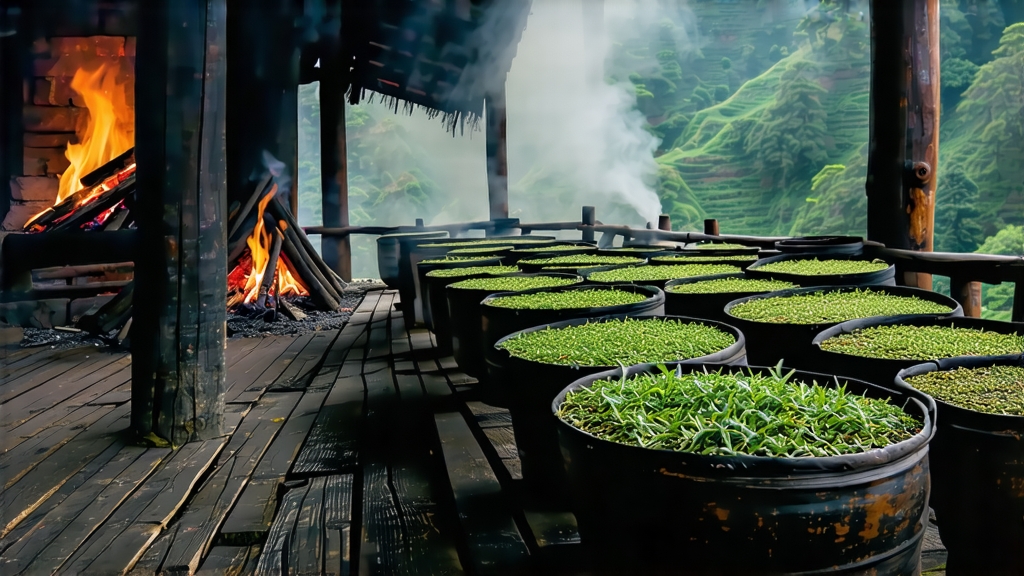
When most tea lovers outside China hear “black tea,” they picture a malty Assam or bright Ceylon, yet the very word “black” is a translation of the Chinese hong cha, “red tea,” and the first hong cha the world ever tasted was Lapsang Souchong. Grown in the granite gorges of the Wuyi Mountains in Fujian Province, this leaf ignited Europe’s tea obsession in 1604 when Dutch traders carried it from the port of Xiamen to Amsterdam. For three centuries it remained the most valuable cargo on the clipper ships; even today, the tiny village of Tongmu—population under two hundred—supplies the only authentic leaf protected by both national origin status and a UNESCO Man-and-Biosphere reserve.
History: From Ming-Era Accident to Global Passion
Local legend says Lapsang Souchong was born during the late-Mian military chaos of 1567–72. A Qing dynasty garrison passed through Tongmu and commandeered the tea sheds; anxious farmers, desperate to dry their freshly rolled leaves before the soldiers returned, dried them over green pine fires. The smoky aroma proved irresistible to the next merchant caravan, and by 1604 the Dutch East India Company had listed “bohea” (the Fujianese pronunciation of Wuyi) at 80 silver guilders per pound—more than double the price of fine silk. The British East India Company copied the recipe in India but never captured the subtle resin-sweet balance; instead they switched to unsmoked Assamica varieties, and Lapsang retreated into cult status, beloved by Winston Churchill, Tolstoy, and, more recently, whisky blenders seeking natural peat notes.
Terroir: Why Only Tongmu Tastes Like Tongmu
The Wuyi range is a 60-km arc of weathered granite cliffs where warm, humid air from the East China Sea meets cool mountain currents. Morning fog lingers until noon, filtering sunlight into a soft, diffused glow that slows photosynthesis and concentrates amino acids. The soil is a coarse, mineral-rich grit locals call “rock bone”; it drains instantly yet holds just enough moisture for the small-leaf Camellia sinensis var. sinensis cultivar “Xiao Ye Zhong.” Attempts to transplant cuttings to nearby counties yield tea that is pleasant but lacks the signature longan-fruit sweetness and the ability to absorb pine smoke without turning acrid.
Leaf Grades: From Souchong to Congou
Within Tongmu, three grades are recognised:
- Pure-bud Lapsang (Jin Jun Mei) – invented only in 2005, made solely from spring buds, unsmoked, honeyed and cocoa-like.
- Smoked Lapsang Souchong – the classic, using the fourth and fifth leaves (souchong means “sub-sort” in Cantonese) withered over pine fires.
- Wuyi Congou – a twisted, keemun-style leaf that is withered naturally and given only a whisper of smoke for balance.
Craft: The Eight Stages of Pine-Fire Alchemy
- Plucking: Dawn mist still clings when pickers take one bud and two leaves, never after 10 a.m.
- Solar Withering: Leaves are laid on bamboo mats in direct sun for 20 minutes to soften cell walls.
- Indoor Withering: Moved to the upper loft of the wooden tea factory, they rest 4–6 h while mountain breezes reduce moisture to 60 %.
- Rolling: A 45-minute gentle kneading on rattan trays breaks leaf cells just enough to release enzymes without bruising.
- Oxidation: In cedar-lined boxes the leaves turn from jade to copper over 3 h at 24 °C; masters sniff every 15 minutes, chasing the scent of ripe apricot.
- Pan-Firing: A 220 °C wok arrest oxidation in 90 seconds, locking in maltose sweetness.
- Pine Smoking: The signature step. Freshly cut Masson pine and cedar roots smoulder below bamboo trays for 6–8 h; resin oils vaporise and condense on the leaf, forming guaiacol and syringol—the same phenols that give whisky its peaty note.
- Final Drying: 80 °C hot-air tunnels reduce moisture to 4 %, then the tea rests 30 days so smoke integrates, mellowing from campfire to candied pine.